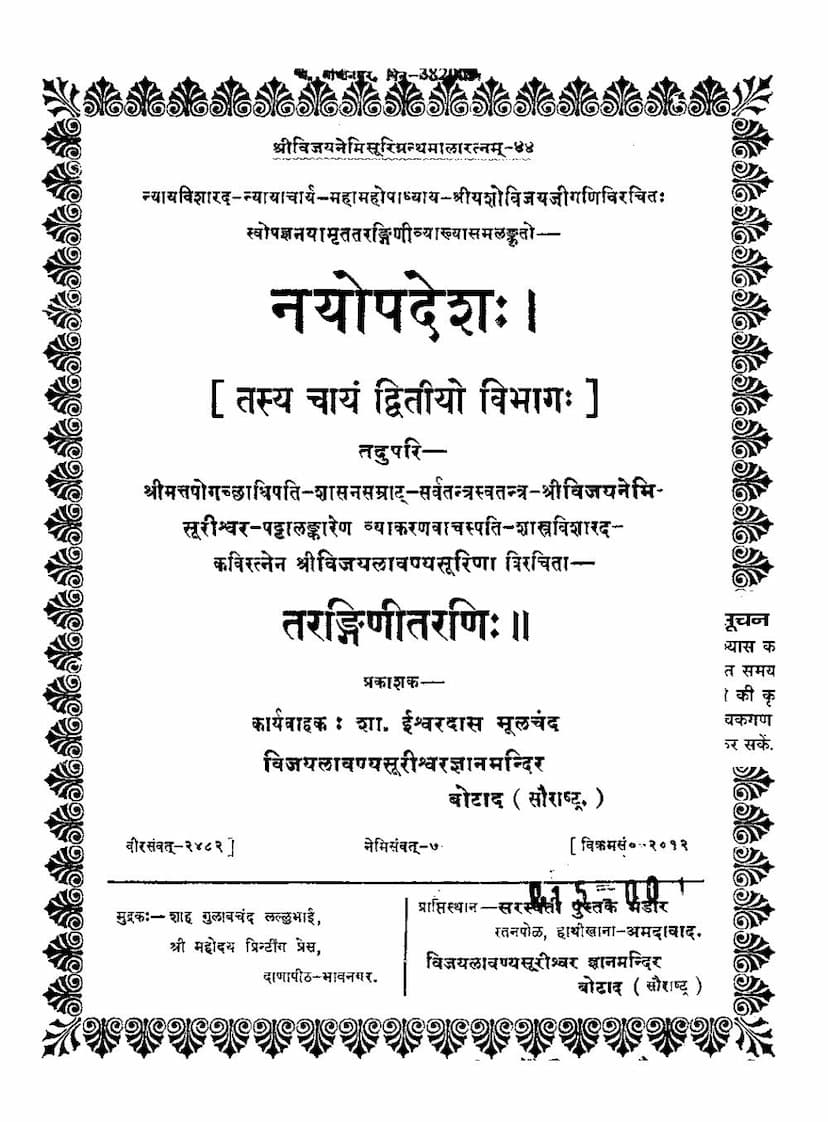Nayopadesha Part 2
Added to library: September 2, 2025

Summary
This Jain text is the second part of "Nayopadesha" (Instruction on the Nayas or Standpoints), authored by Yashovijay Upadhyay and Lavanyasuri. It is published by Vijaylavanyasurishwar Gyanmandir, Botad. The catalog link provided is https://jainqq.org/explore/008445/1. The text is marked for private and personal use by JAIN EDUCATION INTERNATIONAL.
Summary of the Content based on the provided pages and table of contents:
This is a commentary on the "Nayopadesha" text, titled "Nayamrut Tarangini Taranginitarni" (The River of Naya Nectar and its Wave-like Commentary). The book delves deeply into Jain philosophical concepts, particularly the various "nayavadas" (standpoints) and "saptabhangi" (the seven-fold syllogism) as well as "nikshepas" (categories of classification). It also explores various philosophical debates like 'ativad' (extreme view), 'apeksha-buddhivad' (theory of relational cognition), and 'pratibadhya-pratibandhakbhavvad' (theory of dependent and non-dependent cause and effect).
Key figures mentioned:
- Yashovijay Upadhyay: The original author of "Nayopadesha." He is described as a renowned Jain logician and philosopher, honored with the titles "Nyayavisharad" (Expert in Logic) and "Nyayacharya" (Master of Logic). He is noted for winning a debate with a prominent Brahmin pandit, which led to his title "Nyayavisharad." He is also credited with composing 108 works on logic.
- Lavanyasuri: The commentator on "Nayopadesha." He is described as the torchbearer of Jain logic, the successor to the esteemed Vijaynemisuriswarji, and holds titles like "Vyakaranavachaspati" (Master of Grammar) and "Shastra-visharad" (Expert in Scriptures). He composed the commentary "Tarangini Tarani" on Yashovijay's work, aiming to make the profound philosophical concepts accessible to the modern audience.
Publisher and Benefactors:
- Publisher: Vijaylavanyasurishwar Gyanmandir, Botad.
- First Part Benefactor: Raobahadur J. P. Shreshthivarya Jeevatlal Pratap Singh Sanghvi.
- Second Part Benefactor: Shreshthivarya Purushottamdas Surachand. The text provides a detailed biographical sketch of Purushottamdas Surachand, highlighting his business acumen, philanthropic activities, and his contribution to Jainism through the establishment of a Jain temple and educational institutions.
Content Highlights (from the detailed table of contents):
The table of contents is extensive, covering a wide range of topics within Jain logic and philosophy. Some of the major themes and concepts discussed include:
- Analysis of Nayas: Detailed examination of various nayas like Naigama, Sangraha, Vyavahara, Rujusutra, Shabda, Samabhirudha, and Evambhuta. The text discusses the applicability and limitations of each naya, their mutual distinctions, and how they relate to understanding reality from different perspectives.
- Saptabhangi (Seven-fold Syllogism): While not explicitly a separate chapter, the discussions on nayas and the nature of reality are inherently linked to the principles of saptabhangi, which allows for multiple, seemingly contradictory, but valid viewpoints on any subject.
- Nikshepas (Categories of Classification): The text elaborates on the four nikshepas: Nama (Name), Sthapana (Installation/Representation), Dravya (Substance), and Bhava (Mode/State). It discusses the nuances and application of each nikshepa in understanding Jain doctrines.
- Discussions on "Jiva" (Soul) and "Ajiva" (Non-soul): The text engages in deep philosophical discussions regarding the nature of the soul, its characteristics, and its distinction from non-soul substances. This includes debates on the validity of different interpretations concerning the soul's existence, its attributes, and its relationship with the body and the universe.
- Philosophical Debates: The text references and analyzes various philosophical viewpoints, including those from Jain schools and potentially other Indian philosophical traditions (like Vedanta and Sankhya, as indicated by chapter titles and discussions on different philosophical concepts).
- Linguistic and Semantic Analysis: The commentary also delves into the analysis of words, their etymology, and how different nayas interpret the meaning and usage of terms, particularly in the context of Jain scriptures.
- Concept of Reality: The text explores the multi-faceted nature of reality as understood through various philosophical standpoints, emphasizing the Jain principle of anekanta (non-absolutism) and syadvada (conditional predication).
Overall Purpose:
The "Nayamrut Tarangini Taranginitarni" aims to elucidate the profound philosophical principles laid down by Yashovijay Upadhyay in "Nayopadesha." It seeks to clarify complex concepts, resolve apparent contradictions, and provide a comprehensive understanding of Jain logic and metaphysics for scholars and practitioners alike. The commentary is highly detailed, referencing scriptural passages and engaging in rigorous logical reasoning.